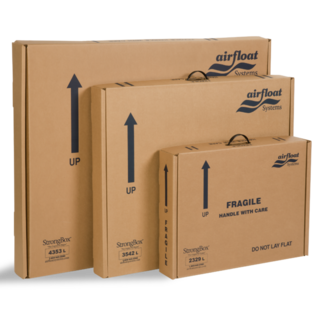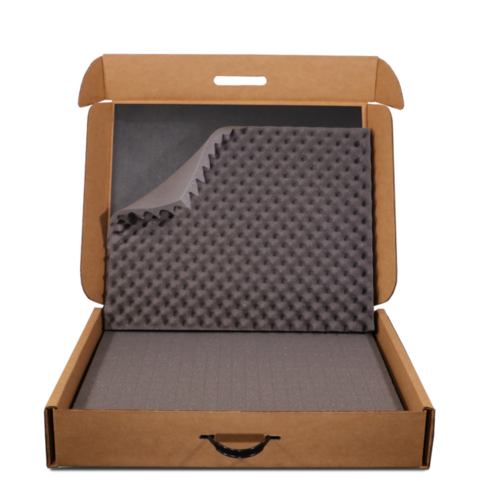How to package your artwork
When you send work around the country or overseas, it pays to wrap it well as no matter how careful you may be with your art, not all couriers have the same respect or care for it. In fact Im sure some see ‘Handle with Care’ as saying ‘Kick here’ while ‘Fragile, please do not drop on corners’ means ‘Football, please throw me against a wall or two’ so wrap well and prevent the chance of any damage happening!
First up, wrap the work securely in a couple layers of bubble wrap. I don’t fold the corners into triangles, I think they protect the corners better if you simply fold them back over and tape down.
Use strong cardboard to create a carton for your package; you can pick these up from appliance or bike stores for example. They usually have large thick cardboard boxes for their stock that they are only too happy to give away. If you can’t get hold of card like that you can purchase corrugated card from places like Warehouse Stationary. Its best to do two layers of this card as its easily punctured. If you do one each way as in the stripes on the card going in opposite directions, you will be able to create a quite strong container.
Place your artwork into the box you have created and fill any open spaces with bubble wrap, packing peanuts newspaper or tissue paper. If you are sending an artwork that has glass in it, then cris-cross tape across the glass surface so in the case of it getting broken, the shards of glass wont puncture and ruin the artwork. Try to make sure your artwork is completely immobile within the box.
Seal the edges with packaging tape and check to make sure that it is secure on all edges.
Double check the address you are sending it too and label the package clearly. I print mine off on my computer so there is no chance of a mistake. Use a clear font and try to include a phone number for the receiver along with your return address and your number.
You can mark the parcel "fragile" I still do. Some services don’t take fragile stuff 9Im sure they’re the ones who think it means football but most will fortunately take reasonable care of your package.
Some couriers will insure your work but some don’t. It pays to check if you think this may be an issue for example if you are sending something to the
How to pack a Flat Print
You need to protect your print properly. Cover your entire print (both front and back) with acid-free tissue paper. Then sandwich the print between a couple pieces of high-quality cardboard on both sides. Tape all edges securely so no moisture can get in. Make sure that the print is not able to move within the packaging and that the board can’t be creased or folded. You would be surprised how often postie’s will try to shove something like this into a letterbox slot and ruining it in the process!
Again double check the address you are sending it too and label the package clearly. I print mine off on my computer so there is no chance of a mistake. Use a clear font and try to include a phone number for the receiver along with your return address and your number. You can put the warning, "DO NOT
There is also the option of rolling it up and sending in a tube, I do this for some of my canvas artworks by taking them off the frame and rolling. Its best to roll them with the artwork facing out as the paint can crack much easier if rolled together for a length of time. Make sure you let the buyer know that they shouldn’t keep it rolled up. If they don’t intend to frame it quickly then store it flat or regularly roll it the opposite way to balance out the tension on the painted surface.
Many shipping firms recommend that, in order to protect artwork and prevent damage to other shipments you should leave at least two inches of cushioning between materials and the outside of the box.
Options for cushioning fragile/valuable items include:
- Crumpled Paper - this is suitable for items which are light and not fragile.
- Bubble Wrap - this is frequently used to protect lightweight fragile and/or valuable items from damage. It can also be reused if removed carefully.
- Polystyrene forms: Polystyrene can be used to create different small forms which can then be used to fill voids simply and easily.
- Foam and Corrugated Liners: Protect heavier works with liners that have some resilience and depth.
- Polythene envelopes - good for keeping work dry - but needs internal stiffening of some sort
- Bubble envelopes - useful and provides some cushioning but also needs a stiffener.
- Poster tubes - are sold for larger/odd shaped works which are sent rolled up.
- Foam core in various sizes and thicknesses is light and robust - use for backing sheets or to provide a sandwich inside which the work(s) go. If taking a sandwich approach then tape the foam core sheets together. You can pick this up from places like Warehouse Stationary or try Real Estate Agents for old sale boards.
- Sheets of corrugated cardboard. This comes in different thicknesses. I prefer foam core as I'm always worried about what would happen if the cardboard got wet.

